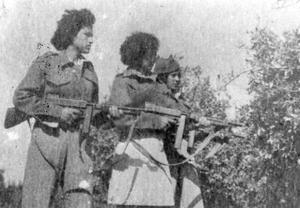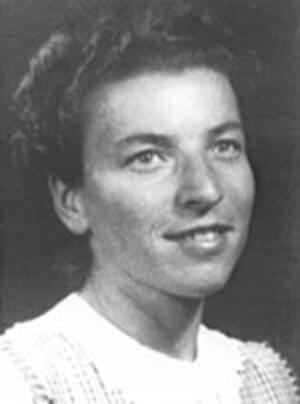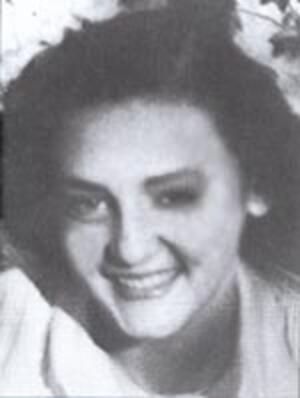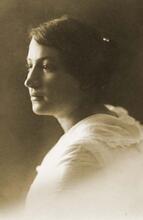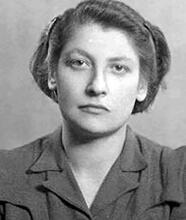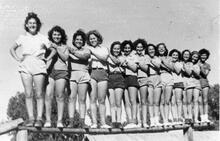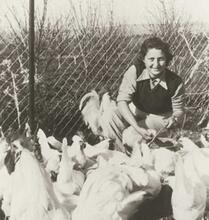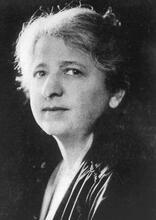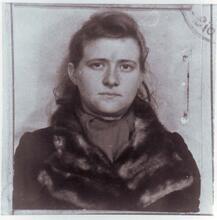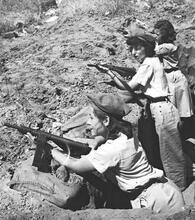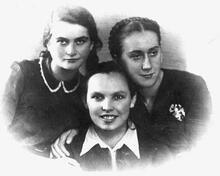Lehi (Lohamei Herut Yisrael)
Three members of the underground Zionist paramilitary organization Lohamei Herut Yisrael (Lehi) during rifle practice, 1948. Source: Wikimedia Commons.
Led by Avraham Stern, Lohamei Herut Yisrael (Lehi) splintered from the underground group Irgun Zeva’I Le’ummi (I.Z.L.) when I.Z.L. called for an end to fighting with the British in 1940. The Lehi used force, blowing up transportation routes and other strategic sites and assassinating British officials, to pressure the British to follow through on the establishment of a Jewish state. Condemned by most Jewish leaders for their violent acts, members of Lehi tried to remain underground for risk of arrest, so the exact statistics about women membership is unknown. It is estimated that women comprised nearly 20 percent of Lehi members, active in all parts of the organization. This entry provides biographical sketches of a dozen of them.
Overview
The underground Zionist paramilitary movement Lohamei Herut Yisrael (“Fighters for the Freedom of Israel,” known by its acronym, Lehi) was founded in 1940 in the wake of the cessation of hostilities against the British rule in Palestine ordered by the commander of the Irgun Zeva’i Le’ummi (I.Z.L.) David Raziel (1910–1941) during World War II. Led by Avraham (“Ya’ir”) Stern (1907–1942), a group opposed this decision, regarding it as mistaken and as losing a rare historic opportunity to take advantage of the war situation to obtain concessions from the British, and Stern led the opposition faction in a split from the I.Z.L.
Stern felt British Mandatory officials should be compelled—by use of force—to fulfill their promise to establish a Jewish state in The Land of IsraelErez Israel: “Even in time of war, England is fighting the Jewish Jewish community in Palestine prior to the establishment of the State of Israel. "Old Yishuv" refers to the Jewish community prior to 1882; "New Yishuv" to that following 1882.Yishuv, attempting to restrict it, and even manages to provide the military forces to prevent the rescue of Holocaust survivors. In reality, Britain is a foreign power, whose interests in the Middle East do not include a Jewish state … we must not cease our war until Britain is expelled and an independent State of Israel is established.”
It is difficult to determine the number of members who supported Stern immediately after the split from the I.Z.L. and who joined him in warfare against the British. No records were kept of those who joined its ranks, nor was there any official office to keep orderly records. There was neither a formal political movement that could provide support for the underground, nor a youth movement that would serve as a reservoir of future members, with records that would offer firm evidence of the size of the membership. Lehi Anashim (People in Lehi: An Encyclopedia of Lehi Members, 2003) lists 840 members while the Association for the Commemoration of the Lehi Heritage lists 1,343 members (not a final list).
Because it never had more than a few hundred fighters at one time, the Lehi frequently used extremist actions, considered by some acts of terrorism, to achieve its goals. Its most infamous actions include the assassination of British Minister of State in the Middle East Lord Moyne in Cairo in 1944 and the joint attack with I.Z.L. on the village of Deir Yasin on April 9, 1948, in which 100 Palestinians, including some civilians, were killed. The primary target of the Lehi’s actions, however, were the British; during World War II the organization even attempted to form an alliance with Mussolini’s Italy and Hitler’s Germany. Due to its extremist tactics, Lehi members were condemned by multiple groups: the British police, the leadership of the Yishuv, and erstwhile comrades-in-arms. Some Lehi members left the organization because they could not withstand the danger to their lives and the possibility of imprisonment.
The number of women active in Lehi can only be estimated. Of the 840 members listed in Lehi Anashim, 168 are women (i.e., twenty percent of the total membership). The proportion of women in the membership lists of the Association for the Commemoration of the Lehi Heritage, which include members whose names do not appear in the book, does not differ significantly: 280 women out of the total of 1,343 recorded members. Based on these data, it may be assumed that this proportion will remain unchanged even if new Lehi members continue to come to light from time to time.
The women chosen in this article represent a cross-section of the twenty percent who served in Lehi.
Women of the “Break-Away”
Women were among the very first to join Stern’s faction upon his split from the I.Z.L. in 1940. Many were veterans of the Betar work brigades and the IZL; some had already taken courses in the use of firearms and provided first aid services during operations or served in the Intelligence Section, in communications, as youth counselors and the like. These bahurot (literally, “girls”), as the young women in the movement were called at the time, constituted the hard core and were a model to be emulated by the women who later joined the Lehi.
In this period, some Lehi members were single men and women who had come to Palestine alone. In order to facilitate the renting of rooms they used the “couples” method, masquerading as husband and wife, since a married couple aroused less suspicion.
The women were highly motivated to immediately participate in the war of liberation, but such rapid action was either prevented or delayed by the conditions existing after the split: lax organization, the loss of arms stores, and the thinning ranks. Many actions were planned, but only a limited number were actually carried out, and the majority of these failed.
Under such conditions, and in the face of the sharp criticism directed against the Lehi within the Yishuv, the organization’s members had to be highly motivated in order to continue the struggle, with unwavering faith in the justness of their cause. In everyday life, the members of the organization were forced to contend with numerous difficulties; some could not bear this constant danger of being shot by British policemen and, in an act of despair, surrendered themselves to the British and were imprisoned.
Not a single woman was among the Lehi members who surrendered themselves to the authorities, electing instead to contend with the existential everyday problems of work, studies, and a place to sleep. Every elementary need proved to involve a difficult and dangerous task. By their actions, these women earned the high esteem in which they were held by their comrades.
Known for her energy and resourcefulness, Juli Torenberg-Elasar (“Hava”), was born on December 20, 1917, to Moshe and Duda Behor, in the village of Kostrochowski, Bulgaria (today Serbia). She attended the main Hebrew school in Sofia and the state High School for Girls. As an outstanding pupil, she was exempted from taking the school-leaving examination. She immigrated to Palestine together with her family on May 19, 1935, and settled in the Lit. "village." The dominant pioneer settlement type of the Jews in Palestine between 1882moshav Bet Hanan. She joined the Rosh Pinnah group of Betar (Revisionist Zionist youth movement) on March 23, 1937, working in the tobacco fields as part of Betar’s work brigade. She joined the I.Z.L. in 1938, having completed her training as a group leader, and moved to Lehi in 1940, where she was appointed commander of the women’s group. Until her arrest in March 1942, she took part in surveillance, arms smuggling, and first aid, and was held in high regard by her comrades. Juli was forced to keep on the move, from one rented room to another. The general suspiciousness that pervaded the Yishuv and the alertness of the neighbors “to prevent acts of hooliganism” led to her being evicted time after time.
Juli relates: “The first operations by the Lehi aroused opposition and hostility. The operations against detectives [i.e., members of the British Criminal Investigation Division] in which Jewish policemen also were killed, the ‘requisition’ of funds from banks which was not well-received, and the libels by the British that we were a fifth column, all erected a wall of enmity around us.”
Ya’ir used her room for underground broadcasts to the Yishuv. His last letter, in which he rejected a suggestion that he seek shelter from the British, who had set a high price on his head, reached her after his murder on February 12, 1942. She perceived it as a bequest. A month later, on March 13, 1942, she was arrested and placed in administrative detention in the Bethlehem Women’s Prison. Released on June 16, 1946, she promptly resumed her underground activities.
After the establishment of the state Juli came to Jerusalem and participated in the battle to free the Old City.
Nelli Langsfelder
Born in 1920 in Vienna to Alexander and Klara Fischer, Nelli Langsfelder (“Hadarah”), Juli’s best friend, had come to Palestine as part of the “illegal” immigration organized by Betar, known as Af-al-Pi (“in spite of”). She served for two years in the Betar work brigades before being accepted into the ranks of the I.Z.L.; when Lehi broke away, she joined it.
Nelli did not lack a place to live, and her livelihood was assured. In her brother’s shoe store, where she worked, she identified the police officers who came to order shoes. The shoe store also served as a mail drop for the underground. Nelli served as a runner, maintaining communications both within the organization and with Max Seligman, the lawyer who defended Lehi prisoners on behalf of the organization. She distributed fliers and other promotional material; and she smuggled pliers and shovels to the organization members in the Mazra’a detention camp, to help them escape. On November 1, 1943, twenty Lehi prisoners escaped through a 70-meter tunnel which they dug.
The Haganah discovered her whereabouts, but she managed to evade those sent to follow her. She left Tel Aviv and went to the moshav of Merhavyah in the Jezreel Valley, where she met Ya’akov Banai, who obtained work for her with the Gabbai family as a domestic, “including much laundry.” She continued her activity in Haifa, where she was arrested in May 1942, and was imprisoned in Bethlehem until July 1946. Ten months later, having resumed her underground activity, she was arrested after the I.Z.L.’s attack on the King David Hotel, when 91 British, Arab, and Jewish soldiers and civilians were killed in an explosion. After her release in May 1948, she joined the Eighth Battalion of the Israel Defense Forces together with other Lehi members.
Ruth Amikam-Schechter
Ruth Amikam-Schechter (“Noa”), originally Gertrud, was born on May 16, 1921, in Vienna to Berta and Benjamin Schechter. At the age of thirteen she and her sister Belle joined Betar, where she was imbued with love of Erez Israel and a desire make Lit. "ascent." A "calling up" to the Torah during its reading in the synagogue.aliyah. She came to Palestine as an “illegal” immigrant, served in the Betar work brigades and joined Stern upon the split from the I.Z.L. She engaged in ramified underground activity before being arrested in Netanyah in 1941. In 1943 she was released to house arrest, but continued her Lehi activity in the Intelligence Section (Section 6) and as a runner between the Lehi Central Committee and the Central Jerusalem Prison, under the guise of visits to a friend. Since the establishment of the state, Ruth has been active historical documentation and memorialization of the Lehi.
Hisya Reuveni-Shapira
Hisya Reuveni-Shapira (“Elinoar”), the daughter of Nette and Pesiah Shapira, was born in a small town in Poland on March 20, 1922. She attended the Tarbut elementary school and gymnasium. She joined Betar at the age of thirteen and became extremely active in one of the local I.Z.L. cells. In 1939 she was recruited to one of the Briha (Escape) groups that illegally crossed the border to Vilna. From there she proceeded with great difficulty to Turkey, reaching Palestine in June 1941. She immediately joined Lehi as a runner to and from Avraham Stern, even on the day he was killed. The fact that she was unknown to both the Jewish police and the British CID aided her in this work. With the establishment of the state she married Nichko Reuveni, a fellow Lehi member. Since city life was too tame for them after their underground activities, they decided to fulfill their egalitarian ideals at A voluntary collective community, mainly agricultural, in which there is no private wealth and which is responsible for all the needs of its members and their families.Kibbutz Kabri in the Western Galilee, where Hisya became engaged in educational and cultural activities.
Reorganizing after Stern’s Death
Lehi suffered a blow to its organization when Stern died in February 1942. Some eighth months later, however, following the escape from detention of “Michael” (Yizhak Shamir) the group began to recover and to reorganize. Almost a year later, on November 1, 1943, twenty Lehi members broke out of the Mazra’a detention camp through a 70–meter-long tunnel that they dug. The escape infused the underground with new energy and strength.
As a means for recruiting new members for underground activities, promotional material was regarded as extremely important by the members of the leadership, as it had been by the heads of Lehi since its inception. The Leadership sought to inform the public by means of the fliers and theoretical pamphlets which the organization distributed. While women did not participate in the writing, they were very active in the printing of the material, the pasting of fliers in the streets, and the distribution of written materials to supporters.
Women participated in most areas of the organization’s activity. They participated in individual acts of terror, in the mining of transportation routes—roads, railroad tracks, bridges, airfields, and the like—as well as of buildings connected with transportation, such as the railroad workshops and other such targets. A number of women were appointed as heads of sections, including the Youth and Recruitment Sections.
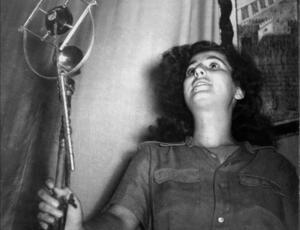
Geulah Cohen, a leading radio broadcaster for the underground Zionist paramilitary organization Lohamei Herut Yisrael (Lehi), during a broadcast, 1948. Photograph by Hans Pinn. Source: Wikimedia Commons.
Geulah Cohen
Geulah Cohen (“Ilana”), born December 18, 1925 in Tel Aviv to Yosef and Miriam Cohen, studied at the Lewinsky Teachers’ Seminary but was expelled for defending the activities of Lehi. Possessed of impressive perseverance and intelligence, she immediately served as a counselor in the Youth Section and was the most outstanding of the women broadcasters on the underground’s clandestine radio. Cohen fulfilled this task unfailingly until February 1946, when the transmitter, at 3 Hashomer Street in Tel Aviv, was discovered and she and the entire radio team were arrested by the British while on the air.
Cohen was also the first woman to escape from prison after two failed breakout attempts. The third time, she succeeded in escaping from the hospital in Jerusalem to which she had been transferred after becoming ill. Taking advantage of a staged fight between Yosef Abu-Ghosh and his friends, she put on Arab woman’s clothing which had been concealed in the bathroom and left the hospital by the front door. Yosef Abu-Ghosh and his friends were arrested. Once free, she resumed broadcasting and devoted herself totally to underground activity.
After the establishment of the state, Cohen completed her studies at the Hebrew University of Jerusalem. She was on the editorial board of Sulam, a journal edited by Yisrael Eldad (Scheib). Her book, Sippurah shel lohemet (The Story of a Woman Fighter), earned her a letter of praise from prime minister David Ben-Gurion.
Cohen was active in the fight to permit Soviet and Ethiopian Jews to immigrate to Israel. She established the National College for Studies of Judaism and Underground and was active in Gush Emunim, the Movement for Greater Israel. In 1978 she was elected to the Lit. "assembly." The 120-member parliament of the State of Israel.Knesset as a member of the center-right party Likud. She resigned from the Knesset in 1992 to protest against the Camp David agreement. She has a weekly radio program called “Right and Left” and heads the UZG Heritage Center, named for the poet Uri Zvi Greenberg.
Sarikah Levi
Sarikah Levi (Shulamit Shamir) was born in Sofia, Bulgaria on April 19, 1923, to Hannah and Eliyahu Levi. Her Sephardi family was traditional in its Judaism. It was in her grandfather’s home that she absorbed her Zionist longings. Attending Hebrew elementary school and a Bulgarian gymnasium, she joined Betar at an early age. When she was in eighth grade she left school and, together with a group of fellow Betar members, immigrated to Palestine illegally, on a rickety boat, arriving in the country in 1941. Stopped by the British, the passengers were arrested and held in the Atlit camp. Upon her release in 1942, she joined the ranks of Lehi. As the runner for “Michael” (Yizhak Yzernitzky Shamir, b. 1915), she was entrusted with especially sensitive tasks, such as transferring the orders for the escape from the Mazra’a detention camp to the twenty Lehi members imprisoned there; in 1944, she accompanied Eliyahu Bet-Zuri to the train to Cairo, unaware that his assignment was to assassinate Lord Moyne.
Shulamit married Shamir, who became Israel’s prime minister in 1983. After the birth of their oldest son, Yair, in 1945, Shulamit continued her underground activities. Arrested in 1947 by the CID, she went on a hunger strike for eleven days. She was released on May 1, 1948. She was a devoted companion to her husband and spent a great deal of time in voluntary work on behalf of the needy and deprived. She established and served as president of the Society for the Elderly. The government of Bulgaria bestowed an award on her for her active role in renewing relations between Israel and Bulgaria.
Hanna Merfish-Stern
Hanna Merfish-Stern (“Nili”), born on September 3, 1924, in Lublin, Poland, to Moshe and Czarina Stern, immigrated to Palestine with her parents, who settled in Jerusalem. At the age of fifteen she joined Betar and later I.Z.L. Upon the establishment of Lehi she decided that it was more in line with her own opinions. At first she engaged in distributing promotional material, affixing posters and serving as a liaison. Specializing in photography, she worked for the official photographer of the British High Commissioner, secretly making duplicate photographs to be used by the Lehi underground.
For eight years, Nili engaged in many areas of underground activity. She participated in sabotage operations such as the blowing up of the Na’aman bridge (near Acre) on April 2, 1946. That same year she laid mines on the road leading to the railroad workshops in Haifa Bay and she also participated in the mining of railroad tracks and trains bringing British troops to Erez Israel and to the neighboring countries.
One of the Lehi fighters in the field, it was said of her that the words “I cannot” were not part of her vocabulary. She managed to evade arrest from 1940 until 1947, when she was among the group of senior Lehi commanders captured by the British in Haifa, as a result of information supplied by an informer.
Ruth-Rahel Kotlitski
Ruth-Rahel Kotlitski (“Edith”), was born in Cracow, Poland, to Meir and Feige-Zipporah Fertig, on November 19, 1924. Her religious Zionist family immigrated to Palestine in 1935 and settled in Tel Aviv. Ruth attended the Talpiot elementary and high schools and joined the Palmah. In 1943 she joined Lehi, where she engaged in educational work, instruction, and organization.
In charge of the recruitment of youth to Lehi, she for years headed the Tel Aviv Youth Section of the organization, the largest in the entire movement. At the time of the disbanding of the undergrounds in 1948, this section included hundreds of young people, whom it provided with their underground training, as well as the basis for their ideological indoctrination.
Describing her first days in this position, Kotlitski later wrote: “I was thrown into the cold water, with no prior preparation. I did not dare to bother the members of the Leadership and ask for directives. With a young woman’s healthy instinct, I drew up a work plan and set three goals for myself: survival … contending with the ostracism, the persecutions and the everyday difficulties; ideology […] the differences between the underground organizations in Erez Israel, gaining knowledge of other liberation movements in the world; and education for love of humanity, the people and the land.”
Women filled every possible role in Section 6 (Intelligence), including fieldwork: surveillance of high-ranking British officials and others; meetings with contacts (Jewish policemen and detectives) in order to obtain information; and allied tasks.
When the state was established Kotlitzki was given her final assignment: to train young people for the switch from the underground to an establishment framework, prior to recruitment to the IDF. After studying sociology and administration, she became an active volunteer in the Association for the Commemoration of Lehi Heritage. In this capacity she organized and managed the research, collecting the material and preparation for printing and publishing of Lehi: Anashim. In 2000 she was elected as one of the nine board members of the Association and its representative on the management of the Yair Publishing House.
Yaffa Badian-Dromi
Yaffa Badian-Dromi (“Avivah”) was born on December 20, 1928, in Gaza, where her father, Shaul Dromi, who immigrated to Palestine in 1921, was among the eighteen families who founded the Jewish community in the town. She studied at the Herzlia Gymnasium in Tel Aviv and joined Lehi when she was still in sixth grade. At first she was employed as a distributor of promotional fliers in the streets, cinemas and schools. Later she was transferred from the youth wing to the underground intelligence service.
She concentrated on work in Section 6 from shortly after her induction into Lehi until the establishment of the State of Israel in 1948. Her work in this section was very demanding and occupied her for long hours every day. As Yaffa herself related, the section’s tasks included listening in on telephone conversations of British officers; the transmission and deciphering of coded messages (one of the encoding methods consisted of the marking of pages, lines and words with a predetermined number); and the photographing and examination of letters by British officials before returning them to the hands of the postal employees for delivery to their original addressees. Badian-Dromi was one of the broadcasters for the Lehi underground radio station in Jerusalem. She was also sent on missions as an arms courier, traveling on public buses because the Lehi did not have access to private vehicles.
Yona Ben-Ami
Yona (Drorah) Ben-Ami (“Meira,” who adopted her nom de guerre of “Drorah” as her official name), the daughter of Israel and Zipporah Raznitsky, was born in Tel Aviv on October 19, 1925. She attended the Nordau gymnasium and became active in Betar at the age of thirteen. Later, she was one of the first to join Lehi after its breakaway from I.Z.L., recruited in 1942 by her older brother Herzl. At that time Lehi had not yet been organized in sections. Ben-Ami underwent “basic training” that consisted of light arms instruction and a course in ideology, and performed every task required of her. She used her typing skills in the preparation of the organization’s newspaper He-Hazit (The Front), a task to which she devoted days and nights, under difficult and exhausting conditions. The newspaper, which appeared regularly, was typed on stencils and hundreds of copies were produced. Both the “printing plant” and her place of residence were frequently changed for fear that their location had been exposed. After two years of this grueling labor, the Lehi leadership decided to transfer the printing of the newspaper, which would now be called Ha-Maas (The Deed), to a modern printing press in Bene Berak.
“Drorah” was selected to accompany Scheib-Eldad from Jerusalem to Tel Aviv after he had been extricated from prison, and they succeeded in eluding the British, who were in pursuit of the fugitive.
Gender Equality in Lehi
The women in the Lehi underground considered themselves as enjoying the same rights and obligations as their male comrades. They also participated in missions that required physical strength, trained with arms, took part in combat, and were active participants in most of the organization’s sections. Women were appointed section leaders; in some actions, women participated as squad leaders and even as operation commander.
Leah Cohen-Granek-Osherov
Leah Cohen-Granek-Osherov (“Yehudit”) was born in Tel Aviv in 1925, the daughter of Henya and Zaddok Oshrov, from whom she learned a love of the Jewish people and Erez Israel. While in high school, she and her friends joined the physical education unit of the Haganah and were sent to a course for unit (class) commanders. In 1943, while she was studying at a teachers’ seminary, she learned of the horrors of the Holocaust and of the concurrent British expulsion of survivor activists, which aroused great anger. While trying to decide on her own line of action, she met her husband-to-be, “Dov the blond,” a Lehi member who was impressed by her views and suggested she join the underground movement. She at once became an active member of the women’s section, engaging in tracking suspects, and in observation, as well as in instruction on the use of firearms and participating in acts of sabotage. One night, while she was affixing posters, she was arrested by the British police. She was imprisoned in Bethlehem for a year and a half and returned to her Lehi activities upon her release.
She was one of the women combatants in the organization. Her male comrades admired her courage, relied upon her ability to command and willingly accepted her authority, both as a weapons instructor and as a commander of operations in the field.
When the state was established she joined the IDF and was appointed an officer in the women’s corps. After the War of Independence she coordinated the organization commemorating the Eighth Brigade, in which most of the Lehi members had fought (1947–1948), and was involved in establishing a memorial at Ujja el-Hafir, a place that commemorated the war’s battles and fallen, among them her husband, the admired Dov (“the blond”) Yaakov Granek.
Leah Prisant
Leah Prisant (“Arielah”), was born on March 13, 1930, to Yaakov Shmuel and Malka Prisant in the town of Rakovitz in the Ukraine. In 1937 she immigrated to Palestine with her mother and brother in order to join her father. She attended the Talpiot elementary and high school in Tel Aviv. From the age of fourteen she was known for her special qualities and talents. Her strong character and passionate desire to live freely in her homeland led her to join Lehi at a young age. She quickly progressed to educational activities with young people and trained them in the use of light arms.
Prisant was renowned as a fighter and a commander. It was said of this charismatic young woman, who led armed actions in Jerusalem, that she was a born commander. Those under her command worshipped her and unquestioningly followed her orders. As “Ehud” relates: “I was placed in a squad commanded by Arielah, with Arielah in the lead, and myself as her second-in-command. I realized that she was quite familiar with the territory, and she unhesitatingly led the force in the dark. I noticed that all the men held Arielah in great esteem, the likes of which I did not witness towards other commanders.”
“Arielah” was killed in an accident in July 1948 that occurred in the weapons depot of Lehi’s Dror Camp in Jerusalem’s Talbiyyeh neighborhood. A detonator exploded, killing five people, including “Arielah.”
Women Prisoners Tried and Imprisoned under the Emergency Regulations
The battle between Lehi and the British authorities was unrelenting. The members of the organization lived under constant pressure of searches, arrests and imprisonment, and death. Numerous women members were arrested on suspicion of belonging to the underground. Even without the proof necessary to convict them in a court of law, they were incarcerated for one-year periods under the powers granted to the British authorities by the Emergency Regulations. After serving the year they were presented with a warrant for another year. Some were tried in British military courts and were sentenced to terms ranging from two or three years to life imprisonment.
When I.Z.L. member Rahel Ohevet-Ami became the first woman to be sentenced to life imprisonment in 1939, she was the only woman political prisoner among the women criminals and insane in the Bethlehem prison. Later, four Lehi women received similar sentences: Frieda Werkstal-Berlin (“Beruriah”), Esther Beckman-Greenstein (“Yael”), Yehudit Revdel-Yehezkel (“Avigail”), and Malka Hepner-Granvitz (“Ruth”), all of whom had participated in the attack on the roads leading to the railroad workshops in Haifa Bay on June 17, 1946. Their task was to prevent interference by the British police and army. The operation was successfully carried out, but the participants’ retreat from the scene was a failure; their car was ambushed by the British, who opened fire on them. Nine men were killed, in addition to two who died in the area of operation. While Frieda and Esther suffered slight wounds, Malka and Yehudit were among the seriously wounded and were disabled. Malka had many bullet fragments in her back and spine and Yehudit’s hands were injured. At their trial they were sentenced to life imprisonment and remained in prison until the establishment of the state.
Nineteen men who had taken part in the same operation, who were arrested and tried together with the women, were sentenced to death. Two weeks later their sentence was commuted to life imprisonment. Although the men initially received harsher sentences, the prison conditions endured by the women prisoners were worse than those of their male comrades-in-arms. At the time there were between twelve and sixteen women I.Z.L. and Lehi inmates in the Bethlehem prison; the number changed as some inmates were released, their places being taken by new prisoners. They were confined in their cells, in small groups of women. The Arab guards displayed a hostile and unbending attitude toward the Jewish prisoners. For most of the day and night, the inmates had only a kardal (the Arabic name for this public bucket) by way of latrine. Only one hour of daily exercise outside the crowded cells was permitted. For years the women had no writing materials or books; they were not even allowed a comb. They were given only spoons with which to eat. The meager prison food was supplemented for a few days each month by the food packages brought by their families during their monthly visits. The visitors also carried letters, which were concealed inside their shoes, in the false bottom of marmalade jars, and the like. Prisoners not granted “special treatment” slept on burshim, a sort of mattress made of rags, without sufficient blankets for the cold Judean Hills winters; nor did they have chairs or any other furniture in their cells. Those prisoners whose families brought them the necessary materials could occupy themselves in sewing or embroidery, but there was no possibility of engaging in intellectual or cultural activity. The single radio, in the corridor, played only Arab music. Most of the other women inmates in this wing of the prison were Arabs, who had been imprisoned for criminal acts.
During the first years of their incarceration, the veteran women prisoners felt abandoned, since the Lehi Central Committee did not maintain ongoing contact with them, but contact with the prisoners improved as time passed.
Frieda Werkstal-Berlin (“Beruriah”) was born in Vilna, Poland, on March 11, 1921, the only daughter of Selig and Adela Berlin. When she was twelve years old she joined the Revisionist youth movement Masada. She attended a Jewish high school and later the Biology Department at the University of Vilna. After the German occupation of Vilna in 1941, her father was sent to his death and Frieda was taken to a concentration camp in Riga. From there she was relocated in turn to twelve other labor camps, finally being liberated by American forces at Dachau. Refusing to be tempted by her relatives’ offers of visas to Australia and Mexico, she sailed for Palestine as a stowaway on a cargo boat. Upon her arrival she linked up with the Jewish underground fighters, where her steadfast spirit brought her to the activities unit of Lehi.
When the British came to search in the attic apartment of Tovah Savorai in Tel Aviv, she was already the mother of a little girl. They found Stern hiding in the apartment. There was a £1,000 reward for anyone who would turn him in, dead or alive. With great courage, she stood between Stern and the British officer who, with drawn pistol, threatened to shoot Stern. “You’ll have to shoot me first,” she said to the officer. Tovah was taken down from the apartment to the police van, and then a number of shots were heard and Tovah shouted, “They’ve killed Ya’ir!” Tovah Savorai spent over four years in the Bethlehem prison.
Summary
While women constituted twenty percent of members, positions in the organization were not apportioned in accordance with this 1:5 ratio. There were no women in the Lehi Executive, High Command, or Central Committee, nor did any write for the organization’s newspaper, thus retrospectively demonstrating the inequality in the underground organization. Nonetheless, there was a sense of equality that stemmed from the esteem in which the female comrades were held by their colleagues. Women fought to be included in the armed operations. Most women served as runners, provided first aid during operations, typed and pasted fliers, and were the cooks in courses.
The dangers they incurred because of these activities were the same as those faced by their male colleagues; a course in Ra’anannah, in November 1947, resulted in the deaths of three young women and two young men. Every activity and every operation entailed mortal danger for the sake of the same idea, the same ideal. This fact determined the egalitarian attitude within the organization, albeit without full equality in practice.
Bauer, Yehuda. From diplomacy to Resistance: A history of Jewish Palestine 1939-1945. Philadelphia: Jewish Publication Society of America, 1970.
Lehi anashim: sipur hayhem shel 840 lohamim velohamot (People in Lehi: An Encyclopedia of Members). Tel Aviv: Yair, 2003.
“Lohamei Herut Israel (Lehi or Stern Gang).” Jewish Virtual Library. https://www.jewishvirtuallibrary.org/lo-x1e25-amei-x1e24-erut-israel
Talmi, Menahem, Aviezer Golan, and Emmanual Katz. Lohamei ha-chofesh be-Yisrael: toldot ha-shomer, ha-haganah, ha-palmach, nili, etzel, lehi (Freedom Fighters in Israel: History of Hashomer, Haganah, Palmach, Nili, Etzel, Lehi). Tel Aviv: Hotsa’at S. Friedman, 1955.

